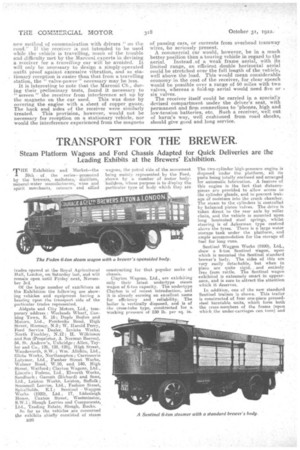WIRELESS TELEPHONY FOR TRANSPORT.
Page 9

Page 10

If you've noticed an error in this article please click here to report it so we can fix it.
Light Thrown on an Important Question by Experiments with a Private Car.
. HE SUCCESSFUL experiment by the Daimler Co. and the Marconi Co., conducted last
week with the object of discovering whether wireless telephony can be enjoyed by passengers in touring cars, has once again raised the interesting question as to whether it can be utilized by the commercial vehicle world for more serious purposes.
The Daimler test, although made under very hurried conditions, and in circumstances in re-gard to installation, type of wireless receiver, and aerial arrangements which will be considerably changed in the final (AM; adopted, clearly indicates that transmission of speech to a travelling vehicle is more than a possibility—it is an accomplished fact.
But, when the possibilities in connection with commercial vehicles are :considered, it is apparent that the conditions in this case are very much more difficult. A touring car, like the Daimler, has a splendid suspension which protects the fragile wireless receiver and itr, delicate valves from much vibration on rough roads. But this difficulty could be overcome by installing the receiver in a case having its own suspension apart from the chassis springs, while as will be seen later—the valves need run no risks if they be removed and carried in a special case when not in use.
It is not likely that the outfit would have to he always connected up for listening-in. Moreover, as a driver could not drive and listen-in at the same time, he would have to carry an assistant for continuous operations.
The economical and practical method of using wireless on commercial motors—when it is availablewe-old he to instute arrangements f or stopping the vehicle at stipulated times, when the driver would connect up, put in valves, and "listen-in."
Given a practical, robust. and efficient receiver, a vehicle could take the fullest possible advantage of the "return load" or " clearing house" schemes. It would be easy for the driver to halt at intervals for instructions from headquarters, but the big 'fly in the ointment" is the matter of transmission.
As things now are, the authorities are very averse from granting transmission facilities to private firms, and when the broadcasting stations settle down to their daily programmes, it may be very difficult to get private or commercial transmissions—with their weaker transmitting power—through the BOO-watt waves of the big stations.
At the moment, the daily broadcasting is planned to start not before 5 p.m., but if in 'response to the public demand, these arrangements are extendedthroughout the working day, we are inclined to prophesy that wireless telephony—even if transmisson facilities to private concerns bepermitted, will not be of any practical use to commercial vehicles.
Will the Message Reach the Right Driver ?
Then there is the important matter of secrecy in regard to commercial messages. There is no secrecy in wireless telephony. But secrecy could be ensured by using Morse in code, and here is another " but " ; would the average driver qualify himself for .Morse reception ? Supposing that speech is relied upon, it would be quite possible for the driver of another firm to intercept a message giving instructions to call at a certain address for a load. If, however, the wireless transmission to the driver is followed by a " land line," or ordinary 'phone or telegraphic message to the address in question, enabling the recipient to identify the driver, an interloper hoping to " snatch" a load would fail to obtain it.
Notwithstanding the technical and other difficulties referred to, it is highly probable that the results of the Daimler test will encourage commercial vehicle users carefully to consider the possibilities of this
new method of communication with drivers " on the road." If the receiver is not intended to be used while the vehicle is travelling, much of the trouble and difficulty met by the Marconi experts in devising a receiver for a travelling car will be avoided, lt will only be necessary to design a simply-operated outfit proof against excessive vibration, and as stationary reception is easier than that from a travelling station, the " valve-power" necessary may be less. It is interestioff to note that the Marconi Cb., during their preliminary tests, found it necessary to " screen" the receiver from interference set up by the magneto on the car used. This was done by covering the engine with a sheet of copper gauze. The back and sides of the receiver were similarly
treated. This. provision, however, would not be necessary for reception on a stationary vehicle, nor would the interference experienced from the magneto of passing cars, or currents from overhead tramway wires, be seriously present. A commercial car would, however, he in a much better position than a touring vehicle in regard to the aerial. Instead of a weak frame aerial, with its limited range, an efficient double horizontal aerial could be stretched over the full length of the vehicle, well above the load. This would mean considerable economy in the cost of the receiver, for clear speech would be possible over a range of N miles with two valves, whereas a fold-up aerial would need five or six valves.
The receiver itself could be carried in a specially devised compartment under the driver's seat, with permanent and firm connections to 'phones, high and low-tension batteries, etc. Such a receiver, well out of harm's way, well cushioned from road shocks, should give good and long service.


































